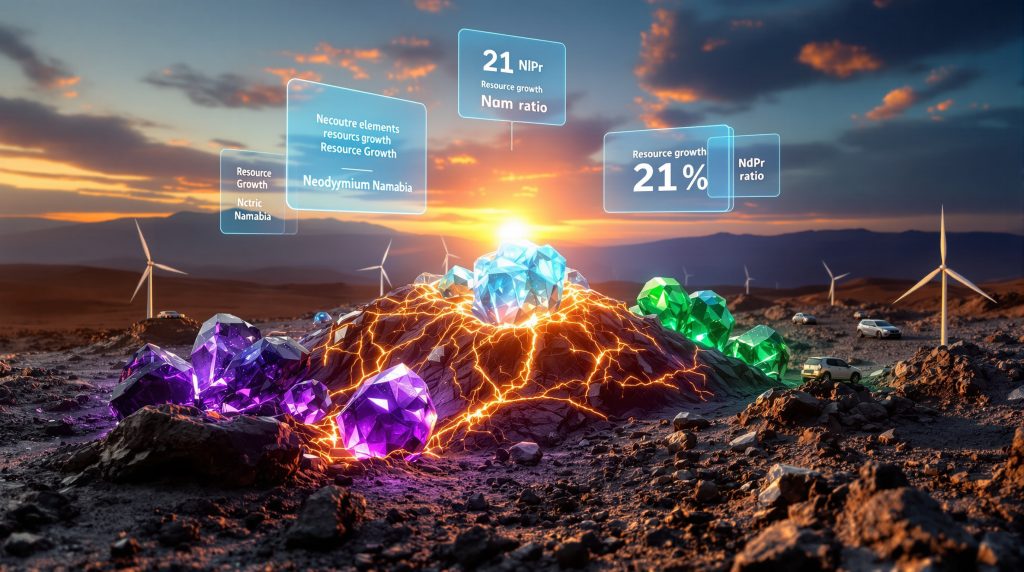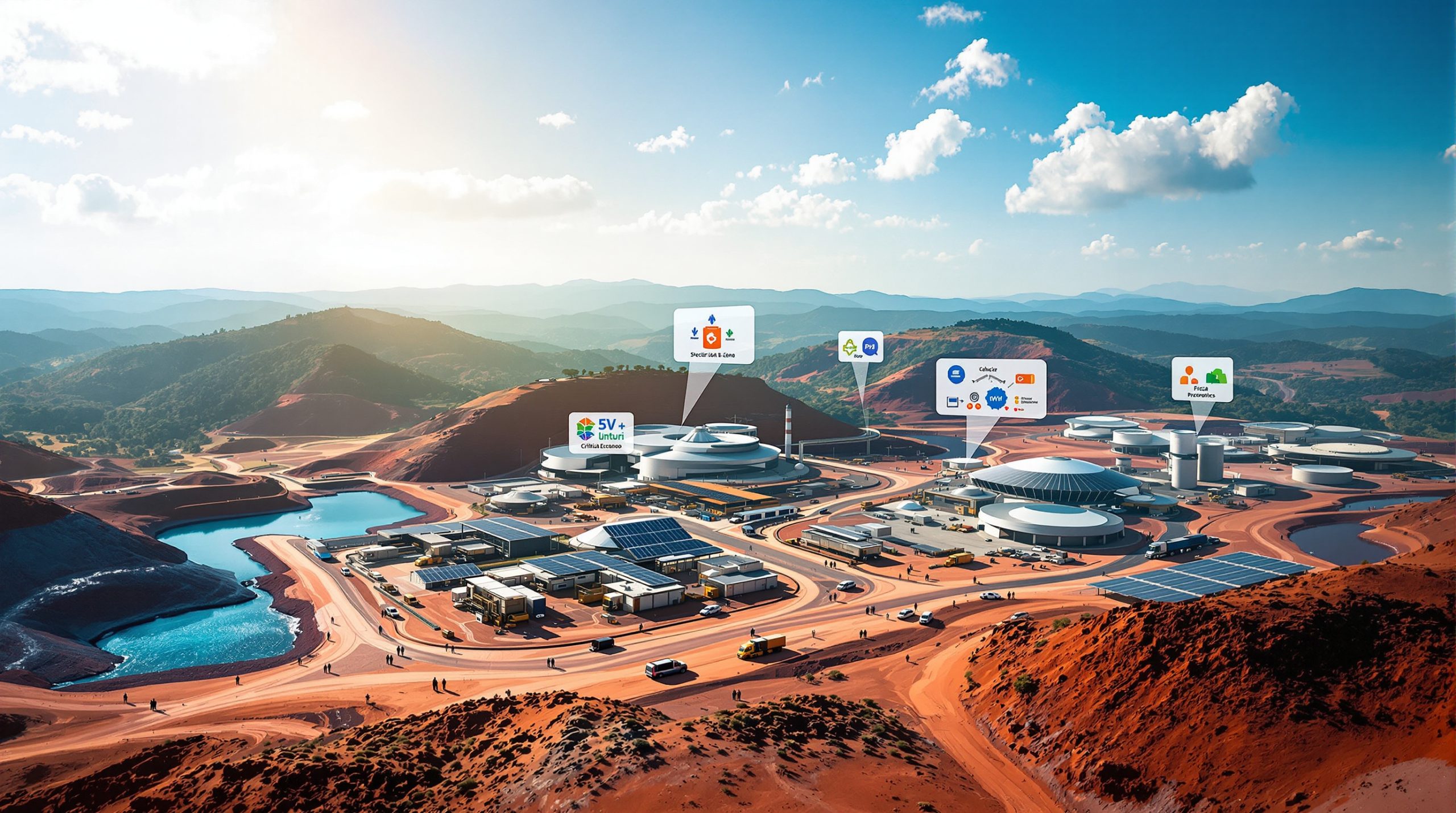What Makes the Kameelburg Project Globally Significant?
The Kameelburg rare earth project in Namibia has firmly established itself among the world's premier rare earth resources following a substantial mineral resource upgrade. With an impressive 85% increase in its total mineral resource estimate, this emerging project now represents one of Africa's most significant critical minerals developments and positions itself among the global elite of rare earth deposits.
The project's prominence comes from its exceptional scale and grade profile, making it a potential game-changer in the global rare earth supply landscape. As rare earth elements become increasingly crucial for the critical minerals energy transition, deposits of this caliber take on strategic importance for technology manufacturers and nations seeking supply chain security.
Key Resource Metrics Revealing Global Importance
The recently updated mineral resource estimate demonstrates the project's exceptional scale and quality:
- 520 million tonnes of inferred resources
- 2.49% total rare earth oxides (TREO) equivalent grade
- High-grade zone containing 271 million tonnes at 2.9% TREO
- Over 1 million tonnes of combined neodymium-praseodymium (NdPr) and niobium pentoxide
These figures represent a substantial resource base by global standards, with particularly favorable characteristics for magnet production and industrial applications. The combination of scale, grade, and strategic metal content creates a compelling value proposition for potential development.
The project's significance extends beyond raw numbers. Its geological characteristics and favorable mineral composition make it particularly well-suited for producing the specialized materials needed in high-technology applications and the renewable energy sector.
How Does Kameelburg Compare to Global Rare Earth Benchmarks?
When comparing Kameelburg to other global rare earth projects, several metrics stand out that position it among the upper echelon of development opportunities worldwide. Its resource profile shows favorable characteristics across multiple dimensions that matter to end-users and processors.
Strategic Metal Content and Quality Indicators
The Kameelburg project distinguishes itself through several key quality metrics that determine commercial value and processing economics:
| Quality Factor | Kameelburg Performance | Global Context |
|---|---|---|
| NdPr Ratio | 21% | Top quartile globally |
| Resource Scale | 520 million tonnes | Largest in Africa |
| Grade Profile | 2.49% TREO (avg) | Competitive with major global deposits |
| Geological Classification | Carbonatite-hosted | Similar to Saint-Honoré (Canada) |
The project's 21% NdPr ratio significantly exceeds typical ionic clay deposits and positions it in the top quartile among hard-rock rare earth projects globally. This high ratio is particularly valuable for permanent magnet manufacturing, which drives demand in electric vehicles and renewable energy technologies.
Industry analysts note that projects with NdPr ratios above 20% command premium interest from potential strategic partners, as these elements face the tightest supply-demand dynamics among the rare earth family. The high NdPr content makes Kameelburg's output particularly well-suited for high-performance magnet applications.
Geological Classification and Global Peers
Geologically, Kameelburg now stands as a peer to the renowned Niobec/Saint-Honoré carbonatite deposit in Quebec, Canada – one of North America's premier rare earth and niobium resources. This classification places it among an elite group of carbonatite-hosted deposits known for their favorable metallurgy and processing characteristics.
Carbonatite deposits typically offer advantages in mineral liberation and processing compared to some alternative deposit types, potentially leading to more straightforward extraction methods. The geological similarity to established operations provides a roadmap for potential development approaches and processing technologies.
Global benchmarking places Kameelburg among the top three rare earth projects of its kind worldwide, according to Mining Weekly's industry analysis. Its combination of scale, grade, and metallurgical characteristics creates a rare convergence of positive attributes for resource development.
What Development Potential Remains at Kameelburg?
Despite the impressive resource already defined, significant expansion potential remains at Kameelburg. The current resource estimate likely represents only a portion of the overall mineralized system, with multiple vectors for potential growth.
Expansion Opportunities and Exploration Upside
The Kameelburg deposit remains open in multiple directions, suggesting substantial resource growth potential:
- Strike extension potential to both east and west
- Depth continuation below current drilling
- Adjacent tenement exploration beginning in October
The upcoming Phase 2 drilling campaign will target these expansion zones, with geophysical and geochemical surveys planned to identify additional high-grade targets on adjacent ground. Given that the current resource represents only part of the mineralized system, substantial growth potential remains.
Geological indicators suggest the potential for discovering additional high-grade zones that could further enhance the project's economic profile. The fact that many carbonatite systems globally contain multiple mineralized centers increases the probability of additional discoveries within the broader project area.
Resource expansion work will focus particularly on delineating additional high-grade zones, which could potentially improve the overall project economics by allowing selective mining approaches that prioritize higher-value material in early production phases.
How Does Namibia Position This Project Strategically?
The Kameelburg project benefits significantly from its location within Namibia, a country with several attributes that enhance its attractiveness for mineral resource development. These jurisdictional advantages play an important role in the overall investment proposition.
Infrastructure Advantages and Jurisdictional Benefits
Namibia offers several strategic advantages for rare earth development:
- Stable mining jurisdiction with established regulatory framework
- Existing transportation infrastructure near the project
- Growing recognition as an emerging critical minerals hub
- Potential for integrated development with other regional resources
Namibia has established itself as one of Africa's more stable mining investment destinations, with a transparent mining code and established procedures for resource development. The country has a history of successful mining operations across multiple commodities, providing a foundation of skilled labor and support services.
The project's location within Africa's established mining corridor provides logistical advantages for future development and potential partnerships with strategic end-users seeking secure supply chains. Namibia's port facilities offer export options for processed materials to global markets.
Recent government initiatives have focused on developing value-added processing within Namibia rather than simply exporting raw materials, potentially creating opportunities for more advanced processing facilities that could enhance the economic benefits of the project for both investors and the host country. Furthermore, with the recent Namibia mining update, the country continues to demonstrate its commitment to responsible resource development.
What Makes Rare Earth Elements Strategically Important?
Understanding the strategic importance of rare earth elements provides essential context for evaluating the Kameelburg project's significance in global supply chains and technology development.
Critical Applications and Supply Chain Significance
Rare earth elements, particularly those found at Kameelburg, serve essential roles in modern technology:
- Neodymium and Praseodymium (NdPr): Critical components in high-performance permanent magnets used in electric vehicles, wind turbines, and defense applications
- Niobium: Essential for high-strength steel alloys, superconducting materials, and aerospace applications
- Other Rare Earth Elements: Applications in catalysts, glass polishing, ceramics, and various high-tech industries
The concentration of both rare earths and niobium in a single deposit creates significant strategic value, as these elements face supply constraints and growing demand in clean energy and advanced manufacturing sectors.
Global rare earth supply chains remain highly concentrated, with approximately 60% of production and 85% of processing capacity currently located in China. This concentration creates strategic vulnerabilities for technology manufacturers and defense systems that rely on these materials, driving interest in developing alternative supply sources.
Market forecasts project substantial growth in rare earth demand, particularly for magnet materials like neodymium and praseodymium. The International Energy Agency estimates that reaching net-zero emissions goals could increase rare earth demand for clean energy technologies by 600-700% by 2040, creating potential supply gaps that new projects will need to fill.
How Does Aldoro Plan to Advance the Project?
With a significant resource now established, Aldoro has outlined a comprehensive strategy to advance the Kameelburg project toward potential development. This multi-faceted approach addresses both resource expansion and technical development needs.
Near-Term Development Strategy
Aldoro's advancement plan includes:
- Phase 2 drilling campaign beginning October 2025
- Geophysical and geochemical surveys on adjacent tenements
- Targeting high-grade rare earth zones for potential resource expansion
- Continued metallurgical testing to optimize processing approaches
The company aims to further define the resource while exploring opportunities for strategic partnerships that could accelerate development timelines. The focus on high-grade zones suggests a potential phased development approach that could reduce initial capital requirements.
Technical work will likely focus on establishing optimal processing routes for the carbonatite-hosted mineralization, drawing on experience from similar deposits globally. The dual-commodity nature of the deposit (rare earths plus niobium) creates opportunities for co-product revenue streams that could enhance project economics.
As the project advances through technical studies, engagement with potential strategic partners and offtake customers will likely increase. The project's scale and quality metrics position it as a potential cornerstone supply source for manufacturers seeking to diversify their rare earth sourcing.
What Distinguishes Kameelburg from Other Global Rare Earth Projects?
Several distinctive characteristics set Kameelburg apart from many competing rare earth projects globally, creating potential competitive advantages in attracting development capital and strategic partnerships.
Competitive Advantages in the Global Landscape
Several factors differentiate this project from competitors:
- Combined Rare Earth and Niobium Resource: Unlike many deposits that contain only one of these critical elements, Kameelburg hosts both in significant quantities
- Favorable NdPr Ratio: The 21% NdPr content exceeds many competing projects
- Scale Potential: Already Africa's largest rare earth resource with substantial growth potential
- Jurisdictional Advantage: Located in a stable mining jurisdiction with established infrastructure
- Metallurgical Characteristics: Carbonatite-hosted mineralization typically offers processing advantages compared to some alternative deposit types
These factors collectively position Kameelburg as a potentially transformative project in the global rare earth supply landscape. The dual-commodity nature provides potential revenue diversification that could improve economic resilience compared to single-commodity projects.
The project's size and grade combination places it in an elite category globally. While some projects may have higher grades but limited size, and others may have large tonnage but lower grades, Kameelburg offers an attractive balance of both attributes that supports potential large-scale, long-life operations.
Market analysts note that projects combining favorable jurisdiction, substantial scale, and high-quality mineralization represent the most attractive targets for strategic investment as technology manufacturers seek to secure long-term supply chains for critical materials.
How Does This Resource Compare in African Context?
Within the African continent, Kameelburg represents a standout resource development opportunity, potentially positioning Namibia as a significant player in the global critical minerals landscape.
Continental Leadership in Critical Minerals
The resource upgrade confirms Kameelburg as:
- The largest rare earth and niobium project in Africa
- A significant development in Africa's growing critical minerals sector
- A potential cornerstone for regional economic development
- A diversification opportunity for Namibia's resource economy
This continental leadership position provides strategic importance beyond purely geological metrics, potentially establishing Namibia as a key player in global critical mineral supply chains.
Africa has traditionally been underrepresented in rare earth element production despite hosting numerous prospective geological terrains. Kameelburg represents an opportunity to change this dynamic, potentially establishing a new hub for critical minerals production on the continent.
The project's scale could support development of specialized technical capabilities and processing infrastructure that might benefit other regional projects, creating potential for a more integrated critical minerals sector across southern Africa. In addition, it could play a crucial role in Australia's strategic reserve considerations as part of broader Indo-Pacific resource security planning.
What Are the Implications for Global Rare Earth Supply?
The emergence of Kameelburg as a world-class resource carries several important implications for global rare earth markets and supply chains, potentially influencing industry dynamics in the coming decades.
Market Impact and Supply Chain Significance
The emergence of Kameelburg as a world-class resource carries several implications:
- Supply Diversification: Reduces dependency on currently concentrated rare earth supply sources
- Magnet Material Supply: Particularly significant for NdPr, which faces potential supply constraints
- Development Timeline: Could align with forecast supply gaps in the late 2020s and early 2030s
- Strategic Partnerships: Likely to attract interest from end-users seeking supply security
As global demand for rare earth elements continues to grow, particularly for clean energy applications, projects of Kameelburg's scale and quality will play increasingly important roles in supply chain development.
Industry forecasts suggest that NdPr demand could double by 2030, driven primarily by electric vehicle production and wind turbine installation. New supply sources will be essential to meet this growing demand while maintaining price stability.
The project's scale suggests potential for long-life operations that could provide supply stability over multiple decades – an attractive characteristic for manufacturers making long-term investments in production facilities that depend on these materials. This aligns with the broader mining industry evolution toward longer-term, sustainable operations.
FAQ: Understanding Aldoro's Namibian Rare Earth Project
What percentage of the project does Aldoro own?
Aldoro Resources holds an 85% ownership stake in the Kameelburg rare earth project in Namibia. This majority ownership position gives the company significant control over development decisions while maintaining a partnership structure with local interests.
What are the primary valuable elements in the deposit?
The deposit contains significant quantities of rare earth elements (particularly neodymium and praseodymium) along with niobium, creating a dual-commodity opportunity. The 21% NdPr ratio indicates a favorable distribution of the most commercially valuable rare earth elements.
How does the project's grade compare to other rare earth deposits?
With an average grade of 2.49% TREO and high-grade zones of 2.9% TREO, Kameelburg offers competitive grades compared to major global rare earth projects. These grade levels support potential economic extraction using conventional processing methods.
What is the significance of the 21% NdPr ratio?
This ratio places Kameelburg in the top quartile globally and makes it particularly valuable for magnet production, as NdPr elements command premium prices and face supply constraints. Higher NdPr ratios typically translate to better economic outcomes as these elements represent the highest-value components within the rare earth basket.
When will the next phase of exploration begin?
Aldoro plans to commence Phase 2 drilling in October 2025, along with geophysical and geochemical surveys on adjacent tenements. This work aims to further define the resource and identify additional high-grade zones.
A Transformative Resource Taking Shape
The Kameelburg rare earth project has emerged as a globally significant resource with exceptional scale, grade, and strategic metal content. Its position as Africa's largest rare earth and niobium project, combined with favorable geological characteristics and development potential, establishes it as a potentially transformative asset in the global critical minerals landscape.
As Aldoro advances exploration and development activities, Kameelburg represents an important diversification opportunity for global rare earth supply chains and a significant economic development opportunity for Namibia. With rare earth demand projected to grow substantially in coming decades, particularly for magnet applications in clean energy and transportation, projects of this caliber will play increasingly important roles in meeting global needs for these critical materials.
The project's combination of size, grade, and favorable metal distribution creates a compelling case for development in a market increasingly focused on supply chain security and diversification. As technical studies advance and strategic partnerships evolve, Kameelburg could become a cornerstone of the next generation of rare earth supply sources supporting the global technology and clean energy transitions, potentially contributing to broader defence critical minerals strategy initiatives across allied nations.
Disclaimer: This article contains forward-looking statements regarding mineral resource potential and market projections. Resource development projects involve numerous risks including technical, financial, regulatory, and market factors that may affect development timelines and economic outcomes. Investors should conduct their own due diligence before making investment decisions.
Ready to Spot the Next Major Mineral Discovery?
Discovery Alert's proprietary Discovery IQ model instantly notifies investors about significant ASX mineral discoveries like the Kameelburg rare earth project, transforming complex mineral data into actionable insights. Understand why major mineral discoveries can lead to significant market returns by exploring the dedicated discoveries page and begin your 30-day free trial today.




